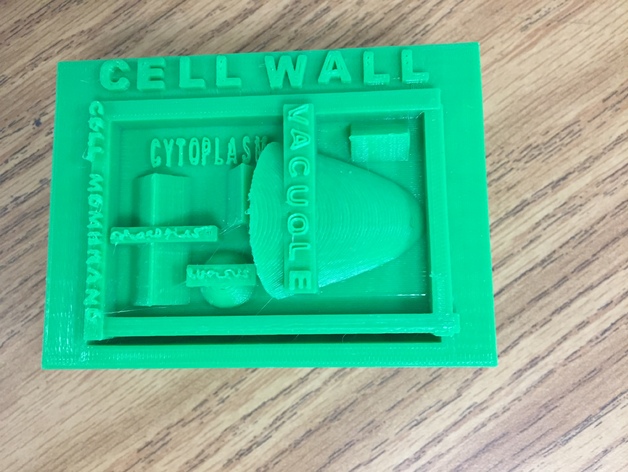
Plant and Animal Cells
thingiverse
Students in a 5th grade classroom learn about plant and animal cells. Students learned how to tell the difference between a plant and animal cell and could compare and contrast the two. Students worked on TinkerCAD to create one of the types of cells. They worked to make sure their cell included the different cell parts and the correct proportions and shape that is characteristic of that cell. Print Settings Printer Brand: MakerBot Printer: MakerBot Replicator (5th Generation) Rafts: Doesn't Matter Supports: Doesn't Matter Notes: *Tips & Tricks • Before printing it's important to go through each student's design to ensure that their creations are printable. For example: We often had students who created parts of their cell that "floated" above other parts instead of actually being connected. Doing a quick check that objects are correctly layered and designed will help immensely when it comes down to printing. • We made sure that if the students created their animal cell with a spherical shape that we cut the bottom of it to make it flat so that it both printed better and then had a bottom to sit on when on display. • We also printed multiple cells on a build plate at a time. It cut down on printing time and allowed the printer to run all day instead of shorter prints that needed to constantly be started throughout the day. Post-Printing Peer Checks After the student's had their printed cells they partnered up with someone and each partner worked to identify the different parts of their partner's cell to test their knowledge. How I Designed This TinkerCAD Students use the TinkerCAD website to create both their plant and animal cells. Standards CCSS Overview and Background Students learn about plant and animal cells and the basic structures of each. Students need to know how to compare and contrast these two types of cells. Students also need to understand the function of each important structure in the cells such as the nucleus, cytoplasm, and the cell membrane or wall. When designing these cells students needed to depict the basic shape of the cell as well as the major structures. Students had to ensure that all of the cell structures were designed according to their correct placement and size within the cell. Objectives Students should be able to identify the different types of cells: plant and animal based on structure, size, and shape. Students should also be able to identify the important structure within each type of cell and explain how it’s function is vital to the cell. Standards Virginia SOL: Science SOL 5.5a The student will investigate and understand that organisms are made of cells and have distinguishing characteristics. Key concepts include: a) basic cell structures and functions Common Core: (Common Core Standard) 6-8.RS.4 Determine the meaning of symbols, key terms, and other domain-specific words and phrases as they are used in a specific scientific context relevant to grades 6-8 texts and topics. (Content Standard) SCI.7.3.1 2010 Explain that all living organisms are composed of one cell or multiple cells and that the many functions needed to sustain life are carried out within cells. Lesson Plan and Activity In class students learn about plant and animal cells unit. Throughout the unit, students identify and understand the important structures of each type of cell and their function. Students understand the basic shape of each type of cell and where the structures can be found within the cell. Students log onto TinkerCAD and learn the basics of 3D design such as grouping, layering, and creating holes. Students are given the chance to choose which type of cell they want to create. Then students create a drawn draft of what they want to create. Students need to make sure their cell drawings are complete with the cell’s correct shape, physical features, important structures, and that everything is proportional. After the student’s draft is approved by the teacher they may begin working in TinkerCAD. Students use TinkerCAD and begin creating their model of the cell they chose. Once students finish the teacher needs to ensure that the creation has all of the components and is ready for printing. Duration of Lesson After students learned about the cell unit in class the actual 3D modeling and creating part took the students two 30-minute computer lab times. Preparation Before beginning in TinkerCAD students need to understand the two major types of cells: plant and animal cells. Students need to have the background knowledge of the cell structure and the different parts within the cell. Students also need to be able to log into TinkerCAD and create objects, holes, and group items. Rubric and Assessment Please see the attached documents for our handouts and assessments. As a handout to learn the vocabulary we use these word wall cards from: https://sites.google.com/a/solteacher.com/olteacher-com/home/fifth-grade/fifth-grade-science-sol-5th/science-sol-5-5a/cell-structures-sol-5-5a We also use these label pages to help students understand the plant parts. Some teachers use this handout as a quiz document as well from:http://www.enchantedlearning.com/subjects/biology/cells/ By the end of the project students should have designed either a plant or animal cell including its important parts. Students will get full credit on their 3D creations if they ensure that their cell the appropriate size, features, and parts. References Brain Pop Intro Lesson:https://educators.brainpop.com/bp-topic/cells/ Cell Lessons and Resources:https://sites.google.com/a/solteacher.com/olteacher-com/home/fifth-grade/fifth-grade-science-sol-5th/science-sol-5-5a
With this file you will be able to print Plant and Animal Cells with your 3D printer. Click on the button and save the file on your computer to work, edit or customize your design. You can also find more 3D designs for printers on Plant and Animal Cells.
